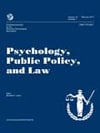
This article summarizes the developmental differences between adolescents and adults, providing implications for differential treatment under criminal law. This is the bottom line of a recently published article in Psychology, Public Policy, and Law. Below is a summary of the research and findings as well as a translation of this research into practice.

Featured Article | Psychology, Public Policy, and Law | 2017, Vol. 23, No. 4, 410-420
Adolescent Brain Science and Juvenile Justice Policymaking
Authors
Laurence Steinberg, Temple University
Abstract
The American legal system’s thinking about the criminal culpability of juveniles has been radically transformed over the past 12 years, largely as a result of the introduction of developmental science into the United States Supreme Court’s deliberations about the appropriate sentencing of adolescents who have been convicted of the most serious crimes. The author examines the role that developmental science, and, especially, developmental neuroscience, has played in this policy transformation. After a brief overview of the Court’s rulings in 4 landmark cases decided between 2005 and 2016, he summarizes the relevant psychological and neurobiological evidence that likely guided the Court’s rulings. The author concludes with suggestions for future research and policy analysis, including (a) the study of developmental differences between adolescents and adults that have implications for their differential treatment under criminal law, with a particular focus on the neural underpinnings of these differences; (b) the study of the impact of variations in juvenile justice policy and practice on outcomes other than recidivism; and (c) the study of the financial costs and benefits of juvenile justice policy alternatives.
Keywords
juvenile justice, adolescent brain development, Supreme Court
Summary of the Research
“Few issues challenge a society’s ideas about both the nature of human development and the nature of justice as much as serious juvenile crime. Because we neither expect children to be criminals nor expect crimes to be committed by children, the unexpected intersection between childhood and criminality creates a dilemma that most people find difficult to resolve. Indeed, the only ways out of this problem are either to redefine the offense as something less serious than a crime or to redefine the offender as someone who is not really a child” (p. 410).
“For most of the 20th century, American society has most often chosen the first approach—redefining the offense—treating most juvenile infractions as matters to be adjudicated as delinquent acts within a separate juvenile justice system designed to recognize the special needs and immature status of young people and to therefore emphasize rehabilitation over punishment … In the latter decades of the 20th century, as violent youth crime rates rose, attacks on the juvenile court intensified. Critics railed at the depiction of young criminals as children, a characterization that was discordant with media images of teenage street gangs spreading fear in urban neighborhoods … Under the mantra of “adult time for adult crime,” young offenders became subject to increasingly harsh punishments, many of them administered by adult criminal courts and sometimes carried out within correctional facilities that had been previously reserved for individuals 18 and older” (p. 410).
“The American legal system’s thinking about the criminal culpability of juveniles has been radically transformed over the past 12 years, largely as a result of the introduction of developmental science into the United States Supreme Court’s deliberations about the appropriate sentencing of adolescents who have been convicted of the most serious crimes … My purpose in this article is to examine the role that developmental science, and, especially, developmental neuroscience, has played in this policy transformation” (p. 411).
“The logical starting point for such a discussion is the landmark U.S. Supreme Court case that abolished the juvenile death penalty, Roper v. Simmons, which was decided in 2005, because the logic that shaped the Court’s decision in this case has had a far-reaching effect on juvenile justice policy and practice, extending well beyond death penalty jurisprudence … Prior to 2005, in the United States, 16- and 17-year-olds who were convicted of homicide could receive the death penalty, and until 2010, individuals under the age of 18 could be sentenced to life without the possibility of parole for homicide and other crimes” (p. 411).
“In a series of cases decided during the past dozen years (see Table 1), the Supreme Court issued rulings that have banned the use of capital punishment and limited the use of life without the possibility of parole in cases involving juveniles who have been convicted of serious crimes and, more recently, opened the possibility for reconsidering the sentences of adults who are presently serving life sentences for crimes they committed as juveniles. The Court’s decisions were increasingly influenced by findings from studies of brain development to support the position that adolescents are less mature than adults in ways that mitigate their criminal culpability, and that adolescents’ diminished blameworthiness makes it inappropriate to sentence them in ways that are reserved for individuals who are deemed fully responsible for their criminal acts” (p. 411).
“In Roper, writing for the Court’s majority, Justice Kennedy explicated three characteristics of adolescents that distinguish them from adults in ways that mitigate their culpability. First, citing evidence of adolescents’ overinvolvement in reckless behavior, Kennedy concluded that adolescents are characterized by immaturity and an underdeveloped sense of responsibility, which leads them to make impetuous and ill-considered decisions. Second, he noted that adolescents are more susceptible than adults to external influences, especially peer pressure, which makes it difficult for them to extricate themselves from “criminogenic” situations. Finally, referencing theories of identity development, Kennedy wrote that the personality traits of adolescents are less fixed than they are in adults, and that this makes it difficult to infer that even heinous criminal behavior during adolescence is evidence of an “irretrievably depraved” character” (p. 413).
“There is strong scientific support for Kennedy’s characterization of juveniles. In general, adolescents and individuals in their early 20s are more likely than either children or somewhat older adults to engage in risky behavior; most forms of risk-taking follow an inverted U-shaped curve with age, increasing between childhood and adolescence, peaking in either mid- or late adolescence, and declining thereafter. Involvement in violent and nonviolent crime also follows this pattern, referred to as the age-crime curve” (p. 413).
“In recent years, several psychologists have theorized that the relationship between age and risk-taking, including criminal activity, is best understood by considering the developmental trajectories of sensation-seeking and self-regulation. Sensation-seeking increases substantially around the time of puberty and remains high well into the early 20s, when it begins to decline. Self-regulation is low during childhood and improves gradually over the course of adolescence and early adulthood. Mid-adolescence, therefore, is a time of high sensation-seeking but still developing self-regulation—a combination that inclines individuals toward risky behavior” (p. 413-414).
“Over the period that spans Roper, Graham, Miller, and Montgomery, several amici assembled and summarized the scientific evidence showing differences between adolescents and adults in psychological capabilities and capacities that are relevant to judgments of blameworthiness. Importantly, they incorporated more and more neuroscience into their briefs, as evidence of significant structural and functional brain maturation during adolescence began to accumulate” (p. 414).
“The relevant evidence that was brought to the Court’s attention in the amicus briefs described a maturational imbalance during adolescence that is characterized by relative immaturity in brain systems involving self-regulation during a time of relatively heightened neural responsiveness to appetitive, emotional, and social stimuli. With respect to self-regulation, structural imaging studies using diffusion tensor imaging indicate immaturity in connections within a fronto-parietal-striatal brain system that supports various aspects of executive function. These connections become stronger over the course of adolescence as a result of both maturation and experience, and the strength of these connections is positively correlated with impulse control. Maturation of structural connectivity in this brain system is paralleled by increases in functional connectivity and by changes in patterns of activation during tasks that measure working memory, planning, and response inhibition (all of which are important for impulse control and thinking ahead)” (p. 414).
“By contrast, numerous fMRI studies show relatively greater neural activity during adolescence than in childhood or adulthood in a brain system, located mainly in the ventral striatum and ventromedial prefrontal cortex, that is known to play an important role in the processing of emotional and social information and in the valuation and prediction of reward and punishment. According to what has been referred to as a “dual systems model,” the heightened responsiveness of this socioemotional incentive-processing system is thought to overwhelm, or at the very least, tax, the capacities of the self-regulatory system, compromising adolescents’ abilities to temper strong positive and negative emotions and inclining them toward sensation-seeking, risk-taking, and impulsive antisocial acts” (p. 414).
Translating Research into Practice
“By all indications, the influence of neuroscience on legal decision-making is growing rapidly, and references to adolescent brain development are appearing regularly in lower court decisions. As psychologists, we should welcome the use of scientific evidence in important legal deliberations. But in discussions of where we should draw legal boundaries between adolescents and adults, neuroscience should continue to play a supporting role, and behavioral science should continue to carry the weight of the argument” (p. 416).
“Further neuroscientific research on three specific issues would be especially helpful to future discussions of adolescents’ criminal responsibility. First, few studies have linked changes in brain structure or function between adolescence and adulthood to changes in the legally relevant behaviors, especially as they play out in the real world. Just because adolescents’ and adults’ brains differ doesn’t necessarily mean that they differ in ways that have legal relevance. It is certainly reasonable to speculate that adolescents who commit crimes make more impulsive decisions than their adult counterparts because their prefrontal lobes are less fully developed, or because their ventral striatum is more responsive to rewards or emotional stimuli. However, this remains largely a matter of what I would characterize as sensible conjecture. More research that directly links age differences in brain structure and function to age differences in legally relevant capacities and capabilities is needed” (p. 416).
“Second, there is growing interest in whether neurobiological data, either alone or in combination with other types of data, can improve the prediction of future behavior at the individual level, either with respect to recidivism or responses to intervention. Although there are studies that have compared juvenile offenders’ brain structure or function with that of nonoffenders, using neuroscience to predict individuals’ future behavior is a different (and more difficult) matter. And, of course, the key question is not what the individual’s brain is like at the time of a trial, but what we expect it to be like at some later point. Furthermore, it is not clear whether using neuroscientific data to foretell individuals’ future offending improves our prediction models by a significant enough degree over standard psychological assessments to warrant the added time and expense” (p. 416).
“Finally, it is not yet clear whether or how recent discoveries about continued brain maturation during the early 20s should lead us to rethink how we treat young adults who come into contact with the justice system. Some writers (generally, nonscientists) have pointed to this research as grounds for raising the age of legal adulthood, at least under criminal law, to age 21 or even 25. This proposition, although intuitively appealing, is potentially problematic” (see article for details; p. 416).
Other Interesting Tidbits for Researchers and Clinicians
“Studies of various justice system interventions find surprisingly few effects on rates of reoffending. The vast majority of juvenile offenders reoffend within a few years of their first offense, regardless of whether they have been treated in the community or in an institutional setting, and regardless of the specific intervention to which they have been exposed. This absence of effects can be looked at through very different lenses. A pessimistic interpretation is that very little works. A somewhat more positive view is that if less expensive interventions are just as effective (or as ineffective) as more costly ones, resources can be saved by opting for the less expensive ones and reallocating the savings elsewhere, perhaps to prevention efforts. A third perspective, and one to which I subscribe, is that perhaps recidivism is not the only metric along which we should evaluate juvenile justice policies” (p. 417).
“A major limitation of research on the consequences of justice system involvement is that it has focused almost exclusively on a single outcome—recidivism, ignoring other important developmental and behavioral outcomes. Yet, adolescents’ experiences with the justice system have the potential to substantially influence their life courses in both direct and indirect ways. For example, the few studies that have examined consequences of juvenile justice experiences other than recidivism has found that juvenile court involvement has a negative impact on educational outcomes, such as high school completion. However, it stands to reason that involvement with the juvenile justice system could affect adolescents’ lives in a range of domains” (p. 417).
“Adolescence is a critical period with regard to many aspects of development, not only academic achievement, such as social relationships, mental health, vocational preparation, and psychosocial maturity. Life events (such as incarceration) that disrupt functioning in one or more of these areas may have greater long-term consequences for adolescents than they do for adults. Apart from its impact on subsequent offending (whether positive or negative), justice system involvement may engender considerable human costs and/or benefits that have gone unrecognized and unaccounted for due to an exclusive focus on recidivism as the outcome of interest. Moreover, an absence of research on outcomes such as education, adjustment, employment, and family formation limits our ability to determine just what it is about incarceration that increases, rather than diminished, the odds of reoffending” (p. 417).
Join the Discussion
As always, please join the discussion below if you have thoughts or comments to add!






















